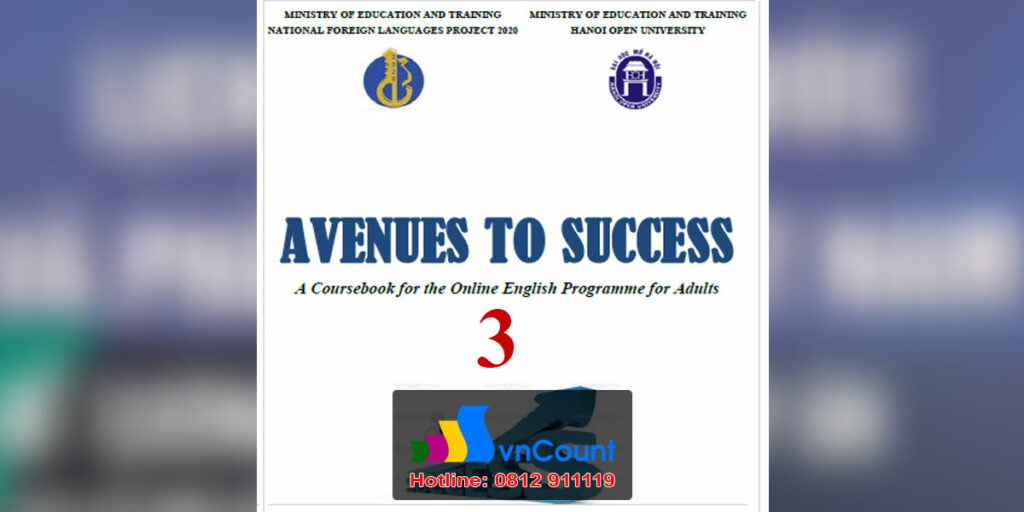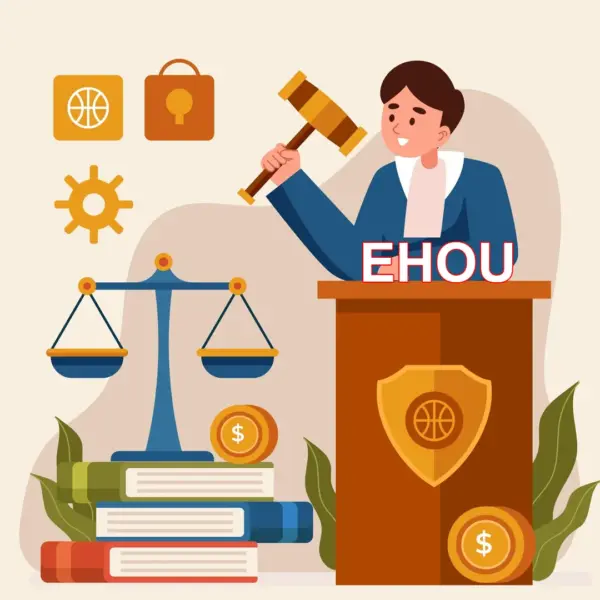Học phần Anh Văn 3 EG09.3 EHOU này trang bị cho sinh viên vốn từ tiếng Anh kinh tế thông dụng trong giao dịch thương mại, sản xuất trao đổi hàng hóa, đàm phán,… (tăng thêm lượng từ vựng khoảng 2000 từ); cách sử dụng và phân biệt một số thì trong tiếng Anh, cách chia động từ phù hợp theo từng tình huống. Sau khóa học, sinh viên sẽ tự tin với khả năng thảo luận nhóm về một vấn đề, nghe, hiểu và nắm bắt thông tin trong các tình huống, viết được các văn bản giao dịch thương mại, đọc hiểu được những bài xã luận (chủ yếu là về chủ đề thương mại, kinh doanh).
Mẹo Nhỏ Nên Đọc Qua
1. Để tìm kết quả nhanh thì nên sử dụng Máy Tính thay vì Điện Thoại.
2. Sau khi Sao chép (Copy) câu hỏi thì bấm “Ctrl + F” và Dán (Paste) câu hỏi vào ô tìm kiếm sẽ thấy câu cả lời. (Copy nguyên câu không ra thì thử vài từ để kiếm)
3. Trường hợp không tìm thấy câu hỏi. Lúc này vui lòng kéo xuống dưới cùng để đặt câu hỏi mục bình luận. Sẽ được trả lời sau ít phút.
4. Xem danh sách đáp án Trắc nghiệm EHOU
5. THAM GIA KHẢO SÁT VỀ CÂU HỎI (Khảo sát giúp chúng tôi biết sự trải nghiệm của Bạn, Bạn có thể đóng ý kiến giúp Chúng tôi tăng trải nghiệm của bạn. Đặc biệt chúng tôi chọn ra 1 người may mắn mỗi tuần để trao Mã Kích Hoạt LawPro 30 Miễn Phí)
6. Tham gia group Facebook Sinh Viên Luật để được hỗ trợ giải bài tập và Nhận Mã Kích hoạt tài khoản Pro Miễn Phí
7. Nếu đăng nhập mà không thấy đáp án thì làm như sau: Giữ Phím Ctrl sau đó bấm phím F5 trên bàn phím “Ctrl + F5” để trình duyệt xóa cache lúc chưa đăng nhập và tải lại nội dung.
Đáp Án Trắc Nghiệm Môn EG09.3 – EHOU
Chỉ Thành Viên MemberPro Mới xem được toàn bộ đáp án.
Click chọn vào hình ảnh để xem chi tiết gói MemberPro. Hoặc lựa chọn tùy chọn và cho vào giỏ hàng để mua ngay. Hoàn tiền 100% nếu không hài lòng.
MemberPro
Bạn có thể mua gói Member Pro 100 ngày tương đương 1 kỳ học hoặc gói Member LawPro 1000 ngày tương đương hết 3 năm học để xem và làm trắc nghiệm hết tất cả các môn tải tài liệu về in ra mới chi phí rẻ nhất
Hoặc bạn cũng có thể chỉ mua riêng lẻ môn này dưới đây
Môn EG09.3 EHOU
Xem được toàn bộ câu trắc nghiệm của môn này. Có 2 phiên bản là chỉ xem online và có thể tải tài liệu về để in ra
Mua xong xem đáp án Tại đây
14. ………is necessary after hard work.
– (Đ)✅: Relaxation
– (S): Relax
– (S): Relaxed
– (S): Relaxing in
33………. you turn it down a bit,please!
– (Đ)✅: Can
– (S): Should
– (S): Can’t
– (S): Shouldn’t
34. …….. you speak Japanese?
– (Đ)✅: Can
– (S): Could
– (S): Should
– (S): May
35. A……………..diet is one that helps maintain general health.
– (Đ)✅: Healthy
– (S): Health
– (S): Unhealthy
36. Alex always assumed that he would be a doctor.
– (Đ)✅: He wanted to be a doctor for a long time.
– (S): He went to medical school.
37. Circle the answer that matches the meaning of each bold word or phrase. Adolescence is a time of independence, so a teen will appreciate the opportunity to make a space that is truly her own.
– (Đ)✅: in the stage between childhood and adulthood.
– (S): in the stage from 6-10 years old
38. Circle the answer that matches the meaning of each bold word or phrase. As more adults get involved with do-it-yourself (DIY) projects, it’s only natural for teens to want projects of their own.
⇒ the art or practice of doing one’s own decorating, repairs…
⇒ a skill you need to do a project
39. Circle the answer that matches the meaning of each bold word or phrase. My uncle has a farm.
⇒ an area of land used for growing crops, breeding and keeping cow, sheep, pigs…
⇒ a place for skiing
40. Circle the answer that matches the meaning of each bold word or phrase. Teens who are looking for a quick afternoon do-it-yourself project would likely enjoy creating items out of duct tape.
⇒ a band of cloth
⇒ thing made from plastic
41. Circle the answer that matches the meaning of each bold word or phrase. Though the primary goal should be to let teens express themselves
⇒ the first thing you want to gain/get
⇒ the thing you like
42. Circle the answer that matches the meaning of each bold word or phrase. We live in the country about four miles from school.
⇒ a measure of length equal to 1,7 km
⇒ one kilometre
43. Circle the best title for the reading text. Color Matters for What You Wear Clothes are like a second skin. Most likely you feel good when you wear your favorite color. What happens when someone sees you wearing any color – for example blue? Does the color send a message? What do you think about pink and blue for children? One of the most common examples of color symbolism in clothing is the custom of using pink for girls and blue for boys, but it wasn’t always this way. This tradition emerged at the turn of the 20th century. Since pink was thought to be a stronger color, it was best suited for boys; blue was more delicate and dainty and best for girls. In 1921, the Women’s Institute for Domestic Science in Pennsylvania endorsed pink for boys, blue for girls. Even more interesting is the fact that pink is the color for baby boys and blue is the color for baby girls in Belgium today. Another interesting fact about pink is that pink is a very masculine color in Bermuda. Also, British bankers and barristers have wom pink shirts for decades. Pink goes in and out of fashion in other parts of the world. White is the traditional color for a bride’s wedding gown in the U.S. and most European cultures. White symbolizes purity and innocence. What about the color wom for weddings and funerals? In Asia, white is the color of death. This arises from the belief that death is seen as a beginning and that white represents the purity that the deceased brings into the next life. Therefore, brides in Japan and China wear red in traditional wedding ceremonies. White is also associated with death in India, where widows wear white. Consequently, red or pink saris are the most popular colors for brides. What about black clothes? Black symbolizes death and is the traditional color of mouming in Western cultures. Black clothing is associated with powerful forces in many parts of the world. Bad and good Witches, the devil, ninjas, cat burglars, Darth Vader, Cat Woman, and Batman wear black….and so do priests, nuns, judges, mimes, Mennonites, Bedouins, and monks. Maybe the common thread is that these people are signaling their seriousness of purpose – or the need to be hard to see – or both. Here’s something else to think about: What happens when the same people wear green? Are they as powerful? Are the priest and nun as respectable?
⇒ Colors and what you wear.
⇒ Colors and kids.
⇒ Colors and your personality.
44. During their vacation,they didn’t have phone service or Internet service
⇒ They were in a remote location.
⇒ They didn’t have a cell phone.
45. Each bold word below has more than one meaning. Circle the right meaning in the text. Do-it-yourself projects teach teens important skills, engage their minds in fruitful pursuits and give them tangible rewards for hard work
⇒ to take part in
⇒ to attack
⇒ to employ
46. Find the topic sentence the following paragraphs: Summer is my favorite season. I enjoy summer sports like water skiing and baseball. The weather is usually sunny and hot, so I can go to the beach almost every day. Gardening is my hobby and I spend many summer days working in my garden. Unfortunately, the days pass too quickly in summer.
⇒ Summer is my favorite season.
⇒ I enjoy summer sports like water skiing and baseball.
⇒ The weather is usually sunny and hot
47. He has a big stamp…
⇒ Collection
⇒ Collect
⇒ Collective
⇒ Collector
48. He lost her credit card, so he ……. pay for the meal.
⇒ couldn’t
⇒ can’t
⇒ shouldn’t
⇒ wouldn’t
49. He lost his credit card, so he …….. pay for the meal.
⇒ couldn’t
⇒ wouldn’t
⇒ can’t
⇒ shouldn’t
50. He……….in electronics at the
⇒ Specializes
⇒ Specialty
⇒ Special
⇒ Specially
51. International interest in the Mediterranean diet began…..
⇒ in the 1950s
⇒ in the 1970s
⇒ thousands of years ago.
⇒ in the 1990s
52. Listen and chosse the main idea of the text. TRACK 2.1.mp3
⇒ A Game Show
⇒ A Sport Game
⇒ An Auction
53. Listen and circle the main idea of the text. TRACK 2.1.mp3
⇒ A Sport Game
⇒ A Game Show
⇒ :An Auction
54. Listen to commentaries 1 and 2 again and circle the answer that best complete each statement. Track 4.1.mp3 seconds. It’s a very fast time – __
⇒ 9.97
⇒ 7.97
⇒ 9.79
55. Listen to Gilles Philips, a journalist, talk about the effects of file-swapping technology on the music industry. Choose the best option for question 1-6. Track 9.3.mp3 The speaker thinks the music industry should
⇒ listen to their customers
⇒ change their client base
⇒ make file-sharers pay fines.
56. Listen to Gilles Philips, a journalist, talk about the effects of file-swapping technology on the music industry. Choose the best option for question 1-6. Track 9.3.mp3 What mistakes has the music industry made in the past?
⇒ It has concentrated too much on short-term profit.
⇒ It has ignored the importance of reality TV.
⇒ It hasn’t spent enough on marketing.
57. Listen to Gilles Philips, a journalist, talk about the effects of file-swapping technology on the music industry. Choose the best option for question 1-6. Track 9.3.mp3 Which of the following should the music industry do?
⇒ invest more in the right talent
⇒ increase the price of CDs
⇒ spend less on big names like Eminem
58. Listen to the following talk and decide which its main idea is. TRACK 1.4.mp3
⇒ The Origins of Shaolin kung fu
⇒ Kung fu in China
⇒ Shaolin Temple
59. Listen to the story. Choose the best title. TRACK 1.2.mp3
⇒ The Wrong House
⇒ My Aunt’s House
⇒ The Old House
60. Listen. Circle the main idea of the radio programme. Track 5.1.mp3
⇒ Mike Davis tells about his life
⇒ Jive Davis tells about the subjects that he’s interested in
⇒ Mike likes working on the farm
61. My brother loves to fix cars.
⇒ He’s good at repairing mechanical things.
⇒ He has a car that he likes to repair.
62. Office workers “admit being rude” Most office workers say they are rude or bad-mannered at work. Two out of three workers regularly arrive late for meetings, most ignore emails and three out of four use bad language. In a survey of 1,000 workers, two-thirds say that pressure of work is the reason for bad manners. Other common examples of bad office etiquette include ignoring colleagues and answering mobile phone calls during meetings. Using mobile phones in meetings is impolite and distracts others, research by the University of Surrey shows. If you respond to call when speaking to somebody, it means that the phone call is more important than the person, the survey said. If you answer a call during a meeting, it could mean that the meeting is not important. Mr Jacobs, managing director of Office Angels, a recruitment firm say it is easy for people to forget their manners in the working environment, which is often very informal and very busy. Workers can forget proper etiquette such as introducing people at meetings, and this is often bad for working relationships. Psychologist Dr Colin Gill believes that people are not as polite as they were twenty years ago. He said: Courtesy is no longer something that is so much respected in our society.’ People think it is ‘stuffy to be polite or formal.’ Now some organisations are actually investing money in training their junior managers to be polite. Office Angels is encouraging people to arrive on time for meetings, tum off mobile phones and avoid bad manners at work is such a simple thing to do, Mr Jacobs says, ‘ and it can have a dramatic impact on improving your working environment and your relationships with others.’ The author wants to ….
⇒ give specific examples of bad manners at work
⇒ give advice on how to behave politely at work
⇒ give specific figures of bad manners at work
63. Read the text and do the activities that follow. The 1001 night The Thousand and one nights is probably one of the most famous books in the world. It is a collection of stories first told by travelers from Persia, Arabia, India and China between the ninth and thirteenth centuries. In later years professional storytellers also told the stories in coffee houses in Turkey, Egypt and many other countries. The Thousand and one nights contains well-known stories like Aladdin and Ali Baba and the Forty Thieves, so people often think they are just for children – but they were originally for adults. Shahrazad’s story There was once an Indian King called Shahriyar. One day King Shahriyar found his wife with another man so he killed her and her lover. After that the King married a different woman every day and killed her the next morning before she could stop loving him. This continued for three years. Shahrazad was the clever and beautiful daughter of the King’s adviser. When her father told her what was happening, she decided to marry the King. Shahrazad’s father tried to stop her because he knew she was going to die. But Shahrazad had a plan to save herself and all the women in the kingdom. The King and Shahrazad got married a few days later. After the wedding, while the King was drinking with his friends, Shahrazad went to find her sister. ‘I need your help,’ said Shahrazad. ‘Come to the palace this evening and ask me to tell you a story’. So that night, Shahrazad was getting ready for bed when her sister came to visit her. She began telling her sister a story called The Fisherman and the Genie. While she was telling the story, the King came into the room. He started listening to her story too, and became more and more interested. Shahrazad continued telling the story all night, but she stopped just before the end and said, ‘The morning’s here, husband. Am I going to die now?’. ‘No, no’, said the King. ‘Tell me the end of the story’. ‘I’ll tell you this evening, but not before’, said Shahrazad with a smile. That night Shahrazad finished the story – and then immediately began another. This continued night after night. The King never heard the end of a story until the next evening. He couldn’t kill his wife because he always wanted to know how each story ended. As time passed, the King fell in love with Shahrazad. He knew he could never kill her because he couldn’t live without her and her stories. To show Shahrazad he really loved her, the King married her again. The stories Shahrazad told the King became the stories of The Thousand and one nights. Choose the best answer Who listened to Shahrazad’s story?
⇒ both
⇒ her sister
⇒ the King
64. Read the text and do the activities that follow. The 1001 night The Thousand and one nights is probably one of the most famous books in the world. It is a collection of stories first told by travelers from Persia, Arabia, India and China between the ninth and thirteenth centuries. In later years professional storytellers also told the stories in coffee houses in Turkey, Egypt and many other countries. The Thousand and one nights contains well-known stories like Aladdin and Ali Baba and the Forty Thieves, so people often think they are just for children – but they were originally for adults. Shahrazad’s story There was once an Indian King called Shahriyar. One day King Shahriyar found his wife with another man so he killed her and her lover. After that the King married a different woman every day and killed her the next morning before she could stop loving him. This continued for three years. Shahrazad was the clever and beautiful daughter of the King’s adviser. When her father told her what was happening, she decided to marry the King. Shahrazad’s father tried to stop her because he knew she was going to die. But Shahrazad had a plan to save herself and all the women in the kingdom. The King and Shahrazad got married a few days later. After the wedding, while the king was drinking with his friends, Shahrazad went to find her sister. ‘I need your help, said Shahrazad. ‘Come to the palace this evening and ask me to tell you a story’. So that night, Shahrazad was getting ready for bed when her sister came to visit her. She began telling her sister a story called The Fisherman and the Genie. While she was telling the story, the King came into the room. He started listening to her story too, and became more and more interested. Shahrazad continued telling the story all night, but she stopped just before the end and said, ‘The morning’s here, husband. Am I going to die now?’. ‘No, no’, said the King. ‘Tell me the end of the story’. ‘I’ll tell you this evening, but not before’, said Shahrazad with a smile. That night Shahrazad finished the story – and then immediately began another. This continued night after night. The King never heard the end of a story until the next evening. He couldn’t kill his wife because he always wanted to know how each story ended. As time passed, the King fell in love with Shahrazad. He knew he could never kill her because he couldn’t live without her and her stories. To show Shahrazad he really loved her, the King married her again. The stories Shahrazad told the King became the stories of The Thousand and one nights. Circle the best answer Who listened to Shahrazad’s story?
⇒ both
⇒ her sister
⇒ the King
65. Read the text and do the activities that follow. The 1001 night The Thousand and one nights is probably one of the most famous books in the world. It is a collection of stories first told by travelers from Persia, Arabia, India and China between the ninth and thirteenth centuries. In later years professional storytellers also told the stories in coffee houses in Turkey, Egypt and many other countries. The Thousand and one nights contains well-known stories like Aladdin and Ali Baba and the Forty Thieves, so people often think they are just for children – but they were originally for adults. Shahrazad’s story There was once an Indian King called Shahriyar. One day King Shahriyar found his wife with another man so he killed her and her lover. After that the king married a different woman everyday and killed her the next morning before she could stop loving him. This continued for three years. Shahrazad was the clever and beautiful daughter of the King’s adviser. When her father told her what was happening, she decided to marry the King. Shahrazad’s father tried to stop her because he knew she was going to die. But Shahrazad had a plan to save herself and all the women in the kingdom. The King and Shahrazad got married a few days later. After the wedding, while the king was drinking with his friends, Shahrazad went to find her sister. ‘I need your help, said Shahrazad. ‘Come to the palace this evening and ask me to tell you a story’. So that night, Shahrazad was getting ready for bed when her sister came to visit her. She began telling her sister a story called The Fisherman and the Genie. While she was telling the story, the King came into the room. He started listening to her story too, and became more and more interested. Shahrazad continued telling the story all night, but she stopped just before the end and said, ‘The morning’s here, husband. Am I going to die now?’. ‘No, no’, said the King. ‘Tell me the end of the story’. ‘I’ll tell you this evening, but not before’, said Shahrazad with a smile. That night Shahrazad finished the story – and then immediately began another. This continued night after night. The King never heard the end of a story until the next evening. He couldn’t kill his wife because he always wanted to know how each story ended. As time passed, the King fell in love with Shahrazad. He knew he could never kill her because he couldn’t live without her and her stories. To show Shahrazad he really loved her, the King married her again. The stories Shahrazad told the King became the stories of The Thousand and one nights. Circle the best answer How was her story?
⇒ interesting
⇒ boring
⇒ bad
66. She’s…. over her weight.
⇒ Obsessed
⇒ Obsession
⇒ Obsessive
⇒ Obsess
67. Text 1 Bad manners at work Etiquette is the name we give to the rules for being polite in a social group. Business etiquette is important for people who often have to make new contacts and build relationships in their work. Politeness can also help to improve the working environment for people in the same office. Some cultures and situations are formal, which means that we have to follow rules; other cultures and situations are more informal. Text 2 Office workers “admit being rude” Most office workers say they are rude or bad-mannered at work. Two out of three workers regularly arrive late for meetings, most ignore emails and three out of four use bad language. In a survey of 1,000 workers, two-thirds say that pressure of work is the reason for bad manners. Other common examples of bad office etiquette include ignoring colleagues and answering mobile phone calls during meetings. Using mobile phones in meetings is impolite and distracts others, research by the University of Surrey shows. If you respond to call when speaking to somebody, it means that the phone call is more important than the person, the survey said. If you answer a call during a meeting, it could mean that the meeting is not important. Mr Jacobs, managing director of Office Angels, a recruitment firm say it is easy for people to forget their manners in the working environment, which is often very informal and very busy. Workers can forget proper etiquette such as introducing people at meetings, and this is often bad for working relationships. Psychologist Dr Colin Gill believes that people are not as polite as they were twenty years ago. He said: ‘Courtesy is no longer something that is so much respected in our society. People think it is ‘stuffy to be polite or formal.’ Now some organisations are actually investing money in training their junior managers to be polite. Office Angels is encouraging people to arrive on time for meetings, tum off mobile phones and avoid bad manners at work is such a simple thing to do, Mr Jacobs says, and it can have a dramatic impact on improving your working environment and your relationships with others.’ The aim of the texts is to ….
⇒ reflect the fact of officer’s bad manners at work with illustrations
⇒ encourage officer’s bad
⇒ manners at work reflect the fact of officer’s good manners at work with illustrations
68. Text 1 Bad manners at work Etiquette is the name we give to the rules for being polite in a social group. Business etiquette is important for people who often have to make new contacts and build relationships in their work. Politeness can also help to improve the working environment for people in the same office. Some cultures and situations are formal, which means that we have to follow rules; other cultures and situations are more informal. Text 2 Office workers “admit being rude” Most office workers say they are rude or bad-mannered at work. Two out of three workers regularly arrive late for meetings, most ignore emails and three out of four use bad language. In a survey of 1,000 workers, two-thirds say that pressure of work is the reason for bad manners. Other common examples of bad office etiquette include ignoring colleagues and answering mobile phone calls during meetings. Using mobile phones in meetings is impolite and distracts others, research by the University of Surrey shows. If you respond to call when speaking to somebody, it means that the phone call is more important than the person, the survey said. If you answer a call during a meeting, it could mean that the meeting is not important. Mr Jacobs, managing director of Office Angels, a recruitment firm say it is easy for people to forget their manners in the working environment, which is often very informal and very busy. Workers can forget proper etiquette such as introducing people at meetings, and this is often bad for working relationships. Psychologist Dr Colin Gill believes that people are not as polite as they were twenty years ago. He said: ‘Courtesy is no longer something that is so much respected in our society. People think it is ‘stuffy to be polite or formal.’ Now some organisations are actually investing money in training their junior managers to be polite. Office Angels is encouraging people to arrive on time for meetings, tum off mobile phones and avoid bad manners at work is such a simple thing to do, Mr Jacobs says, ‘and it can have a dramatic impact on improving your working environment and your relationships with others.’ The purpose of some organisations who invest money in training their junior managers to be polite is to …………………
⇒ improve the working environment and relationships with others
⇒ help them more famous
⇒ spend all money they have
69. The patient comes to the hospital in the……………..that he will be cured.
⇒ Belief
⇒ Believe
⇒ Unbelievable
⇒ Believable
70. The……………system in this country is rather complex.
⇒ Educational
⇒ Educated
⇒ Educate
⇒ Education
71. Then circle the answer that best matches the meaning of each bold word or phrase Many illnesses in these temporary refugee camps are the result of inadequate sanitation the building of houses
⇒ to protect people’s health
72. Then circle the answer that best matches the meaning of each bold word or phrase. There’s a high risk of another accident happening in this fog.
⇒ the possibility of something bad happening
⇒ an advantage of an issue
73. Then circle the answer that best matches the meaning of each bold word or phrase. By the 1960s, most households had a TV.
⇒ families
⇒ companies
74. Then circle the answer that best matches the meaning of each bold word or phrase. He claimed that he had been deprived of his freedom.
⇒ take something away from someone
⇒ give somebody something
75. Then circle the answer that best matches the meaning of each bold word or phrase. I feel that I have benefited greatly from her wisdom.
⇒ to be helped by someone
⇒ to be treated badly
76. Then circle the answer that best matches the meaning of each bold word or phrase. Strawberries are in short supply at the moment.
⇒ little of something available
⇒ need to be provided
77. Then circle the answer that best matches the meaning of each bold word or phrase. The area is still very rural and undeveloped.
⇒ in the countryside
⇒ in the city
78. Then circle the answer that best matches the meaning of each bold word or phrase. The manifesto includes tough measures to tackle road congestion and environmental pollution.
⇒ damages caused to air or water
⇒ disadvantages to human beings
79. Then listen again. Circle the answer that best completes each statements. Trac 7.2.mp3 John Bains is interested in
⇒ the environment
⇒ music
⇒ shopping
80. Then listen again. Circle the answer that best completes each statements. Track 8.2.mp3 The inspector questioned Amanda in _____
⇒ the library
⇒ the kitchen
⇒ the living room
81. Then listen again. Circle the answer that best completes each statements. Track 8.2.mp3 Barbara played cards with ___
⇒ Gordon
⇒ Amanda
⇒ Claudia
82. They …… be on holiday but I’m not sure.
⇒ may
⇒ must
⇒ should
⇒ can
83. You ……… enter the country without a visa.
⇒ can
⇒ should
⇒ must







A recruitment firm gives this advice to new workers:
It is important to
time in your relationships with others at
. Get to know the people who work near you:
yourself to them and tell them something about yourself. If people ask for your help, always
positively. Don’t
emails or phone calls just because you are busy. If you make a mistake, it is better to
it and then apologise. When things go wrong, stay calm and
shouting and using bad language. Remember good
help to
your working
, and you will find you can enjoy your work more.
Text 1 Bad manners at work
Etiquette is the name we give to the rules for being polite in a social group. Business etiquette is important for people who often have to make new contacts and build relationships in their work. Politeness can also help to improve the working environment for people in the same office. Some cultures and situations are formal, which means that we have to follow rules; other cultures and situations are more informal.
Text 2 Office workers “admit being rude”
Most office workers say they are rude or bad-mannered at work. Two out of three workers regularly arrive late for meetings, most ignore emails and three out of four use bad language. In a survey of 1,000 workers, two-thirds say that pressure of work is the reason for bad manners.
Other common examples of bad office etiquette include ignoring colleagues and answering mobile phone calls during meetings. Using mobile phones in meetings is impolite and distracts others, research by the University of Surrey shows. If you respond to call when speaking to somebody, it means that the phone call is more important than the person, the survey said. If you answer a call during a meeting, it could mean that the meeting is not important.
Mr Jacobs, managing director of Office Angels, a recruitment firm say it is easy for people to forget their manners in the working environment, which is often very informal and very busy. Workers can forget proper etiquette such as introducing people at meetings, and this is often bad for working relationships.
Psychologist Dr Colin Gill believes that people are not as polite as they were twenty years ago. He said: ‘Courtesy is no longer something that is so much respected in our society.’ People think it is ‘stuffy to be polite or formal.’
Now some organisations are actually investing money in training their junior managers to be polite. Office Angels is encouraging people to arrive on time for meetings, turn off mobile phones and avoid bad manners at work is such a simple thing to do,’ Mr Jacobs says, ‘ and it can have a dramatic impact on improving your working environment and your relationships with others.’
The aim of the texts is to …………………………………….
Chọn một câu trả lời:
a. reflect the fact of officer’s bad manners at work with illustrations
b. encourage officer’s bad manners at work
c. reflect the fact of officer’s good manners at work with illustrations
It is important to
time in your relationships with others at
. Get to know the people who work near you:
yourself to them and tell them something about yourself. If people ask for your help, always
positively. Don’t
emails or phone calls just because you are busy. If you make a mistake, it is better to
it and then apologise. When things go wrong, stay calm and
shouting and using bad language. Remember good
help to
your working
, and you will find you can enjoy your work more.